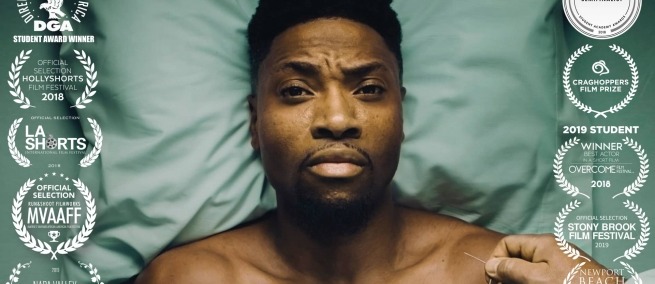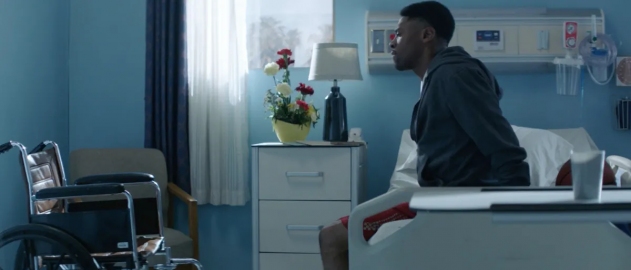
ASIA A is a new feature film currently in development about a college athlete struggling to adjust to paralysis after a spinal cord injury. Writer and director Andrew Reid made a short film version of the story as his thesis film at USC, which is available to stream below. The short film won the Jury Award at the 2018 DGA Student Awards and was a Semi-Finalist for the 45th Student Academy Awards. The feature-length version of the story won a 2019 Sloan Filmmaker Fund grant from the Tribeca Film Institute and is currently out for financing and casting. We spoke with Reid by phone from his home in California.
Science & Film: Can you tell me what ASIA A is about and how you came to the story?
Andrew Reid: It’s about a college basketball player who has a severe injury which leaves him completely paralyzed. He has to come to terms with his paralysis while struggling with the hope of recovery, which is something that a lot of spinal cord patients don’t normally achieve. I’ve seen from my own personal experience that hope can stop you from living in the now, because we’re still holding onto the idea that things might change–it’s finding that balance between holding on for progress in the future while accepting yourself in the moment.
The feature is inspired by my own personal experience in the sense that I was completely paralyzed when I was in college–I was a T3 complete paraplegic. I suffered an injury called an AVM–arteriovenous malformation. Pretty much what that means is that I was born with extra blood vessels in my back. Because I was very athletic in nature, I worked out my back a lot, and my muscle mass was abnormal; like an aneurism it knotted and exploded. The explosion compressed my spine, paralyzing me, and I had to have emergency surgery to relieve the pressure on my spine, but the damage was done. They told me I would never walk again. I gave my life [over] to recovery, which became an obsession. I was fortunate in that I started to see recovery; I was in a wheelchair for the first year, then I was in a walker for a year, crutches for a year, one crutch, and then for the past four or five years I’ve been walking with a cane and I still do my physical therapy three or four times a week. But in that time, I’ve also met a gamut of spinal cord patients and stroke patients and I’ve gone past my personal experiences for the feature—we’re expanding it to universal themes that I want everyone to relate to.
S&F: What has been the process of expanding the short into a feature, in terms of developing the story?
AR: The short focuses on the first step, which is accepting the wheelchair, and it all takes place in the hospital. In the feature, there is the world outside of the hospital room. Once you’re in the hospital you’re kind of disconnected from the world; you’re in this very clinical element which makes you feel safe and like you’re putting your life on pause. But when you come out of the hospital, the pause button has been turned off and you have to find your place in the world. In the feature, we address how this main character, who was the epitome of, say, 21-year-old physical perfection, has to grapple with the fact that the very thing that has defined him has been stripped away, and he has to rediscover himself in this world in a wheelchair. It shows not just his own struggle but the struggle in his relationship with his girlfriend, his father, his occupational therapist who helps to guide him, then also his old friends and the new friends he meets in his life. Even though it’s his story it does have an ensemble cast.

S&F: Where are you now with the film?
AR: Through my agent we’ve gone to several financiers who have expressed interest. It is a character-centric story, very much an actor’s movie, because it relies heavily on the performance, so we’re looking to attach actors right now to go back to the financiers who are interested.
S&F: I know that winners of Sloan grants are often assigned scientific advisors, what has been your experience so far with that part of the program?
AR: I have two advisors. One is Jess Holguin, who is one of the lead occupational therapists at the USC hospital, and I reached out to him even before Sloan. I actually send him drafts of the script and he and some of his colleagues dissect where I’ve gone into fictitious land [laughs], and they have discussions about where I can lean more dramatic and where we need to be truly authentic.
The Sloan mentor who I’ve been working with through Tribeca is Angela Kuemmel, and she is a spinal cord injury patient who works with the VA hospital in Virginia. She has been great with showing us some of the psychological elements of the story. She is a psychologist who works with spinal cord injury vets who are struggling to adjust. We thought her perspective would be invaluable in terms of some of Matt’s psychological journey—Matt is the name of the main character in the feature. We send her drafts of the script and she gives us a write-up of her notes and then we hop on a phone call with Roberto [Saieh], who I wrote the short with. The story is by both of us, but he will be the writer on the feature.
I didn’t want to tell my story—yeah, there are pieces of me in this film—but I wanted to make it something more than that. I wanted it to be something universal, like I said. We deal with themes of self-worth, which is a theme anyone can relate to; you don’t have to be paralyzed to look in the mirror and not be happy with what you see, or to see flaws within yourself, you’re just even more inclined when you have a disability—an adjustment disorder which is what they would call it. One of the things we want to showcase as well are some of the latest rehab advancements with technology, but balancing that with the fact that they’re in very early stages, and also this character is hoping for some of these things to pan out while ultimately needing to accept the reality of the situation in the now.
S&F: Not to relate everything to this, but it does sound a little like our state in the current pandemic which is that yes, we hope for a time when this will be over, but at the same time there is a lot of uncertainty about when that will happen and people have to accept that for now.
AR: Absolutely. It can totally be related to the times we live in now, unfortunately.
S&F: How has it been having the short in the world before you’ve made the feature?
AR: We achieved what we set out to do with the short and people really responded to it. We wouldn’t even be this far, I wouldn’t have an agent, if the short hadn’t made an impact. We got into several festivals, but to me the job isn’t done yet. The short was just a steppingstone to get to this point. Once we get a response from the feature then I can kind of let it go.
♦
ASIA A is set to be directed by Andrew Reid, written by Roberto Saieh, and produced by Jake Katofsky. Stay tuned to Science & Film for more news as it develops towards production. Meanwhile, you watch the short film version of ASIA A below.
FILMMAKERS
PARTNERS
TOPICS